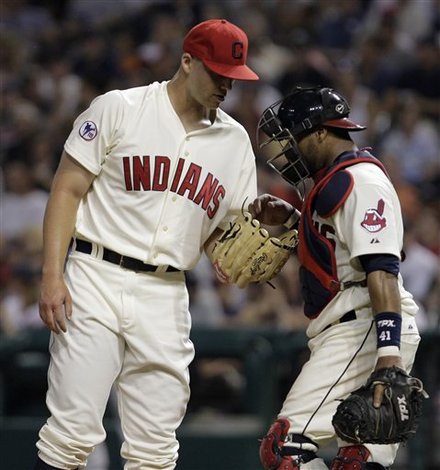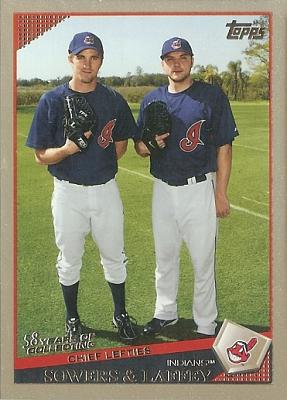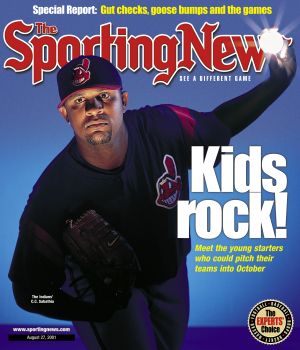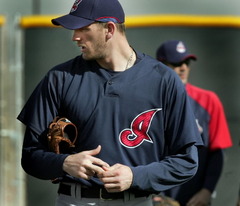 Indians Archive
Indians Archive  Falling Behind in the Arms Race
Falling Behind in the Arms Race
 While the collapse is nearly complete – or at least we all hope that it is – the range of emotions (anger, apathy, etc.) on the North Coast is as varied as the opinions as to what the Indians should/could do (clean house, blow it up, even sell the team with the hope that it stays in Cleveland) to re-emerge into relevance as I can ever remember. You’ve seen the pieces, ranging from the cogent (and, to answer the question in the piece, I’m thinking that an “organizational re-assigment” is in the offing for Radinsky soon – as much as that feels like merely a nominal gesture – with Belcher coming down from the Front Office to replace him) and even-handed to the irrational that devolve into pandering (and no, there are no links there), so I’m not going to re-hash everything that’s been written in the past week as it’s more than a little depressing to think about, much less re-hash.
While the collapse is nearly complete – or at least we all hope that it is – the range of emotions (anger, apathy, etc.) on the North Coast is as varied as the opinions as to what the Indians should/could do (clean house, blow it up, even sell the team with the hope that it stays in Cleveland) to re-emerge into relevance as I can ever remember. You’ve seen the pieces, ranging from the cogent (and, to answer the question in the piece, I’m thinking that an “organizational re-assigment” is in the offing for Radinsky soon – as much as that feels like merely a nominal gesture – with Belcher coming down from the Front Office to replace him) and even-handed to the irrational that devolve into pandering (and no, there are no links there), so I’m not going to re-hash everything that’s been written in the past week as it’s more than a little depressing to think about, much less re-hash.
That said, the overwhelming feeling that I just can’t shake of late is that for the last couple of years, these Indians teams kept making me think that they were simply new incarnations of the 2004 team – full of promising youngsters looking to assert themselves as legit MLB players, who together would be ready to make that next big step that the 2005 team into a 90-win season – but that step simply hasn’t come and if they’re taking any kind of step, it seems to be backwards, particularly as of late. Surely, that’s colored by the events of the last two weeks, but the growing fear is that we’re looking at an assembled collection of players that will be stuck in that 2004 mode (promise and potential, but not realized production) forever here, or maybe worse.
Because as the Tribe now sits on the 3rd worst run differential in ALL of baseball (now worst in the AL), there is a sense that the big step forward that the team took in 2005 and later 2007 may not be coming any time soon. And the reason that I keep coming back to for that step looking so far away is because of the current Tribe’s rotation…and what’s on the horizon for that rotation. Look, I’m going to spare you the gory details about the Tribe rotation as of late, but it was interesting that the 3 players that were called up to “reinforce” the rotation came from the Kearns deal, the Westbrook deal, and off of the scrap heap as it struck me that the Indians continue to have no drafted and developed starting pitching options – viable ones at least, if you’re thinking of Dave Huff – that are anywhere close to contributing, some 3 or 4 years after the rebuild/reload/whatever.
Even more glaring however – when compared to those Indians’ teams of the mid-to-late-2000’s – this incarnation of the Indians lacks that one “stopper” in the rotation, the one that existed back in the early-to-mid-90s, who wore his hat a little crooked and always showed signs of becoming the aCCe that emerged in 2007 (though he disappeared for a few crucial months in 2008) and is now currently and regrettably on display in the Bronx. Because a little less than a decade ago, it’s important to remember that Millwood was a “scrap-heap” signing, Westbrook emerged from middle relief, Fauxberto came out of nowhere as a young(ish) arm, Byrd was a veteran “add” to the mix, and Lee was largely inconsistent until the start of that 2008 season, while CC was the anchor in the rotation, the top-of-the-rotation starter that settled the rest of the rotation and essentially prevented the type of long losing streaks that we just saw with this Tribe. On this Indians team, a “stopper” like that simply doesn’t exist and, as much as we’d like to convince ourselves that Masterson or (gulp) Ubaldo is capable of that, it doesn’t look like a top-of-the-rotation stopper is on this Indians team or, more acutely, anywhere close to Cleveland.
And if you’re talking about a missing “piece” for a team that thought it was going to contend, there it is. So while this past Sunday’s post focused on LaPorta and Carrasco as the missing “pieces” for this Tribe team, in that the 2012 team needed a RH bat (MaTola) and a top-to-middle-of-the-rotation starter (Carrasco) and the failure of those two players to develop/stay healthy left the Indians scrambling for unsuitable back-up plans, let’s take a step back and remember why those “unsuitable back-up plans” (like Lowe, Damon, etc.) were still necessary and why LaPorta and Carrasco even found themselves in the Indians’ organization.
As much hand-wringing and teeth gnashing as there’s been about the “tear-down” of 2008 to 2010, an unquestioned reason that the Indians felt they had to make all of those trades was to infuse the upper levels of the organization with talent because there was a crevasse of talent below that 2004 to 2009 team due to poor drafting, stalled development, or injuries to key prospects. Essentially, the Indians looked at their farm system back in those dark days in 2009 (in particular) and decided that they needed to re-stock with upper level talent because…well, because very little homegrown talent existed and, for teams like the Indians, the only way to fill holes that aren’t filled internally is by trading for close-to-MLB-ready talent or to sign scrap-heap veterans and hope for the best.
 So they infused players at the upper levels, with the two main players in two of the three main deals meant to anchor the lineup (LaPorta) and the rotation (Carrasco) and when those players – LaPorta and Carrasco – hit snags in their development (or worse) via injury or…um, pitch recognition, the Indians were in the same place that they were back in those summers of 2008 and 2009, with no homegrown talent to fall back onto, particularly in terms of the starting rotation. Yes, they had added Masterson – and his 2011 was a sign of brighter days ahead – but in essence, moving Vic and CP Lee for Masterson and Carrasco was deemed necessary because the Indians had produced nothing more than back-end-of-the-rotation flotsam and jetsam (at best) in their drafts and international signings for the better part of a decade
So they infused players at the upper levels, with the two main players in two of the three main deals meant to anchor the lineup (LaPorta) and the rotation (Carrasco) and when those players – LaPorta and Carrasco – hit snags in their development (or worse) via injury or…um, pitch recognition, the Indians were in the same place that they were back in those summers of 2008 and 2009, with no homegrown talent to fall back onto, particularly in terms of the starting rotation. Yes, they had added Masterson – and his 2011 was a sign of brighter days ahead – but in essence, moving Vic and CP Lee for Masterson and Carrasco was deemed necessary because the Indians had produced nothing more than back-end-of-the-rotation flotsam and jetsam (at best) in their drafts and international signings for the better part of a decade
In case you don’t remember (or if you’ve blocked those Trading Deadlines from your memories), the Indians cleared the decks of any and all veterans in a little more than a year and in the process, they targeted arms – lots of them – when those trades were made. All told, 18 players were added from the time DeRosa in early July of 2009 was moved until Westbrook went to St. Louis a year later, with an astonishing 14 arms making up the bulk of the 18 players added. In the present tense, Masterson, McAllister, and Kluber all came as a result of those deals as well as C. Perez and a gaggle of other arms, both interesting (Barnes, Hagadone, etc.) and forgettable (Jess Todd, Yohan Pino, etc.).
But those 14 arms haven’t really been augmented by too much internally (yes, Pestano is phenomenal and Sipp is here) in the rotation by any kind of drafted-and-developed players and that’s where the Indians find themselves, painted into an undesirable corner in terms of expectations for the rotation’s present and future. Maybe you can point to Atom Miller’s perpetually gnarled finger, Rondon’s fractured right elbow (after Tommy John), or Austin Adams’ shoulder injury as reasons that the Indians had to turn to Chris Seddon to make a start while they wait for Fauxberto to return, but the Indians lack of internal reinforcements for the rotation today is stunning and depressing.
As a quick aside here, the invocation of Chris Seddon as an example is not meant to besmirch Seddon (who was actually pretty good in AAA and is LH) as much as it is to point out that the Indians STILL don’t really have young drafted-and-developed arms that figure into the MLB rotation any time soon, other than as the “depth” options that always underwhelm and unfortunately, with the arms from the trades already in MLB for the most part, it’s been that way for a while.
By that I mean, do you want to know the last 6 pitchers drafted by the Tribe to start games for the Indians since the beginning of the 2009 season?
 Josh Tomlin – 54 starts
Josh Tomlin – 54 starts
David Huff – 48 starts
Aaron Laffey – 24 starts
Jeremy Sowers – 22 starts
Alex White – 3 starts
Scott Lewis – 1 start
That group goes back to the 2009 season, so in the last 4 seasons for a team that was unquestionably rebuilding (with opportunity seemingly aplenty), those are the only pitches drafted by the Tribe to start games for them. As we sit here, one of those pitchers is currently in an MLB rotation, and it’s Laffey up in Toronto, where he’s getting a chance because of an impossibly ravaged rotation. Two of those pitchers (Sowers and Lewis) are out of baseball, two are in bullpens (either in MLB – Tomlin, or AAA – White) or is in Columbus (Huff) just waiting for the day when he’s removed from the 40-man roster.
That sextet started only 25% of the games since the beginning of 2009 and again, for a team that was in rebuild mode for a good portion of that where you would think that there would be MANY opportunities, that’s pretty incredible. Yes, you can include Gomez and Fauxberto in there if you’re including the International FA signings, but…unless you see Tomlin or Huff starting a game anytime soon (and I don’t) or see Gomez or Fauxberto in a serious discussion for this team’s rotation in 2013 more so than just being back-end-of-the-rotation fodder, that doesn’t look to be changing any time soon, to the point that Chris Seddon was seen as a more viable option for even a spot start than any of the homegrown, on-the-40-man-roster arms that are (still) in Columbus.
Certainly, it can be argued that the lack of homegrown depth and quality took a MAJOR hit when Alex White and Drew Pomz made their way to Colorado a little over a year ago and you’ll get no argument here as each was a 1st Round Pick, a highly-touted arm that moved quickly through the system with the idea that they would augment a rotation so obviously in need of internal contributions. But this is where the Indians changed course, creating that now-well-publicized “window of contention” with the Ubaldo deal, moving White and Pomz for 2+ seasons of Ubaldo, aligning Jimenez’s control with that of Asdrubal (prior to his extension) and Choo.
The Ubaldo deal was made with the idea in mind that the Indians were acquiring that ready-made “stopper” in the rotation that either didn’t exist or was going to take a while to develop in Pomeranz…if you’ll remember how long it took CC to really assert himself as a consistent bona-fide ace. To that end, the Indians “went for it”, although it should be noted that – at the time the Tribe traded for Ubaldo – they had every indication that Carrasco (who had a 4.25 ERA on July 22, 2011) and the player formerly known as Fausto would be in the mix for 2012 and 2013…at least, meaning that they felt they were actually dealing from a position of depth to acquire that “bird in the hand” with the cost coming as “two in the bush”.
What has transpired since that trade has been beyond catastrophic for the organization, as Carrasco went under the knife, Fausto was exposed as being the Dominican Don Draper, and Ubaldo didn’t come close to resembling the front-end-of-the-rotation “stopper” that they thought they were getting. And slowly, you could see the “window” closing a little with each start by Josh Tomlin or Jeanmar Gomez (depth starters if everything goes according to “plan” from now to then) and now by Chris Seddon as the starting pitching depth quickly turned shallow.
Though Adam Van Arsdale has a marvelous piece over at LGT on“windows”, complete with charts of players that may be ascending to Cleveland, arguing that the Indians window shouldn’t be tied to Ubaldo, the trade of White and Pomeranz – which destroyed the rotational depth, along with Carrasco’s injury and Fausto’s...um, identity “issue” – signaled that the Tribe thought that the pieces (when they made that move) in the rotation allowed them to move their top two starting pitchers in the Minors for what was thought to be a top-of-the-rotation arm. But what’s more troubling is the rotational depth (or lack thereof) contained within one of Van Arsdale’s compelling charts, as the unspoken issue with the Tribe going forward is not confined to LF or to 1B, but is unquestionably in that starting rotation, where there is simply no real help on the horizon other than what look to be complementary pieces.
As I’ve often said, I’m (obtusely) optimistic about the offensive pieces in place, but the Indians lack of arms – and I’m talking “impact” arms that project to be more than “depth” options or back-end-of-the-rotation fodder – is glaring and it’s one of the reasons that I thought guys like Vargas and/or Maholm should have been targeted in the Trade Market. Ultimately, they didn’t have the ammo (in terms of prospects) to get those guys, or at least Maholm, which…again, comes back to drafting and the lack of legitimately compelling options above the High-A level for the Tribe.
So what’s the solution, other than crossing fingers?
Since it’s pretty unlikely that the Indians are about to add an “impact” arm in FA, you’re left with either going into 2013 with the Masterson/Ubaldo/McAllister/Kluber/Gomez/Fauxberto mix or you’re looking at targeting players via trade (likely for Chris Perez or…gulp, Choo) to augment the rotation, with the hope that they can step into the rotation and contribute right away. That seems like an awfully tall order as arms like Gio Gonzalez (who, in hindsight, should have been the target last July…and he may well have been with the A’s asking for a guy like Kipnis in return) rarely are moved without a heavy prospect price being paid for them, a “prospect” price that the Indians simply can’t afford right now.

There is no sports genus with a greater risk-reward ratio than high school pitchers. Like supermodels, they look great, but the chances of entering into a long-term relationship with one are slim. Teams keep drafting them for their visceral gifts, but the toll of throwing so hard so young, their incomplete physical development and the few opportunities to measure them against top competition leave teams spending millions on veritable lottery tickets.
Major league teams signed 102 high school pitchers taken in the first round from 1981 through 2000 (not including supplemental first-round picks). Yet only 15 of those 102 pitchers won 20 games for the team that drafted them, a group that included Dwight Gooden, Roy Halladay, CC Sabathia and Josh Beckett. For every one of those brass rings, there were three total busts. Of those 102 high school first-rounders, 44 never reached the majors.
“Generally they are high risk/high reward,” says Padres G.M. Josh Byrnes, who used three first-round picks this year, including supplemental choices, on high school pitchers. “We realize there is some power in numbers. Hopefully one or two deliver.”
That idea of “hopefully” becomes the pervasive thought with these arms that may or may not develop as it is worth noting that the Indians took THREE High School arms in the 2001 Draft, all in the first 35 picks in the draft, with a fourth HS pitcher taken by the Tribe with the 51st pick in the draft. You probably don’t remember them because none of them – Dan Denham, Alan Horne (who did not sign with the Tribe), JD Martin, and Jake Dittler – made any kind of impact on the Tribe and whether that’s due to “misses” in drafting or development, the Indians have made other high picks for HS arms in the ensuing years.
 Most notably, Atom Miller was the 31st pick in the 2003 draft, with Chris Archer (now a highly-touted 23-year-old pitcher in the Rays’ organization who made it to Tampa by way of Chicago in a couple of trades) being drafted in the 5th Round of the 2006 draft. Though both of those guys are not in the Tribe organization anymore, the Indians have drafted high-ceiling HS arms fairly highly in the recent past with TJ McFarland a Fourth Rounder in 2007, who is now a 23-year-old that just was promoted to Columbus (where he has struggled) after dominating in Akron for the 1st half of this year and Trey Haley, a bonus baby Second Rounder in 2008 who is now a 22-year-old in High-A ball and performing well, as well as Dillon Howard the 2nd Round pick in 2011 and Mitch Brown the 2nd Round pick in 2012.
Most notably, Atom Miller was the 31st pick in the 2003 draft, with Chris Archer (now a highly-touted 23-year-old pitcher in the Rays’ organization who made it to Tampa by way of Chicago in a couple of trades) being drafted in the 5th Round of the 2006 draft. Though both of those guys are not in the Tribe organization anymore, the Indians have drafted high-ceiling HS arms fairly highly in the recent past with TJ McFarland a Fourth Rounder in 2007, who is now a 23-year-old that just was promoted to Columbus (where he has struggled) after dominating in Akron for the 1st half of this year and Trey Haley, a bonus baby Second Rounder in 2008 who is now a 22-year-old in High-A ball and performing well, as well as Dillon Howard the 2nd Round pick in 2011 and Mitch Brown the 2nd Round pick in 2012.
Now, whether any of these young arms develop in the way that (frankly) most young arms don’t – which is to say they succeed and become legitimate ace-material – remains to be seen, and the answers won’t be visible for quite some time. In the interim, the Indians are left doing what most teams around MLB do with starting pitching – seeing if they can find “broken” pieces attached to live arms (think Esmil and this new guy, improbably named Fabio) and “fix” them to the point of effectiveness. But doing that seems to be much easier for relievers and while the Indians have made McAllister and perhaps Kluber into some interesting pieces going forward by adjusting their mechanics, the team is still lacking in front-end arms for now and for the future.
Maybe Masterson and Carrasco can re-capture some of their 2011 success that unquestionably led the Indians to make the Ubaldo move and maybe one of these young starters emerges in a way that Westbrook and Lee did those many years ago or maybe even one of the young, high-ceiling arm explodes in a way that CC (the 20th pick of the 1998 Draft) did over a decade ago, debuting after only two full minor-league seasons.
But those are all “maybes” and for the Tribe, as they currently stand, there are too many “maybes”, particularly in the rotation going forward to see a consistent starting staff in place going forward that projects contention…contention that suddenly seems much further off.
- NBA Announces 2013-2014 Schedule
- Browns Ink Sharknado
- Sharknado A No-Show For Rookie Camp
- Trent Richardson Out Until Training Camp
- Browns Sign Brandon Jackson
- Carrasco Suspended Eight Games
- Browns Add to Wide Receiver Depth with David Nelson
- Browns Need to Learn from Past Draft Mistakes
- Browns Release Chris Gocong and Usama Young
- Browns Missing on Grimes Disappointing, But Not The End
The TCF Forums
- Chris Grant's first 3 drafts
Kingpin74 (Tuesday, January 21 2014 10:13 AM) - The 2014 Offseason Thread
googleeph2 (Tuesday, January 21 2014 9:36 AM) - 2015 Recruiting
furls (Tuesday, January 21 2014 6:57 AM) - Mike Brown
YahooFanChicago (Monday, January 20 2014 11:15 PM) - Movies coming out
HoodooMan (Monday, January 20 2014 9:34 PM) - 2014 Hoops Hockey Hijinx
jpd1224 (Monday, January 20 2014 4:44 PM) - 2014 Recruiting
jclvd_23 (Monday, January 20 2014 2:26 PM) - Wish List - #4 Pick
Hikohadon (Monday, January 20 2014 1:26 PM) - Official- Browns Coach Search/Rumors
OldDawg (Sunday, January 19 2014 6:48 PM) - #1 overall pick Anthony Bennett
TouchEmAllTime (Sunday, January 19 2014 1:28 PM)



